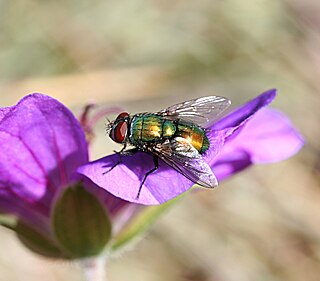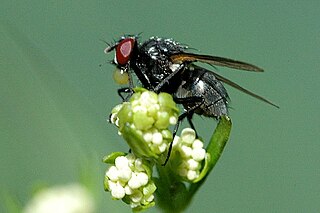Related Research Articles

Forensic entomology is the scientific study of the invasion of the succession pattern of arthropods with their developmental stages of different species found on the decomposed cadavers during legal investigations. It is the application and study of insect and other arthropod biology to criminal matters. It also involves the application of the study of arthropods, including insects, arachnids, centipedes, millipedes, and crustaceans to criminal or legal cases. It is primarily associated with death investigations; however, it may also be used to detect drugs and poisons, determine the location of an incident, and find the presence and time of the infliction of wounds. Forensic entomology can be divided into three subfields: urban, stored-product and medico-legal/medico-criminal entomology.

A maggot is the larva of a fly ; it is applied in particular to the larvae of Brachycera flies, such as houseflies, cheese flies, and blowflies, rather than larvae of the Nematocera, such as mosquitoes and Crane flies. A 2012 study estimated the population of maggots in North America alone to be in excess of 3×1017.

The Calliphoridae are a family of insects in the order Diptera, with 1,200 known species. The maggot larvae, often used as fishing bait, are known as gentles. The family is known to be polyphyletic, but much remains disputed regarding proper treatment of the constituent taxa, some of which are occasionally accorded family status.

The common green bottle fly is a blowfly found in most areas of the world and is the most well-known of the numerous green bottle fly species. Its body is 10–14 millimetres (0.39–0.55 in) in length – slightly larger than a house fly – and has brilliant, metallic, blue-green or golden coloration with black markings. It has short, sparse black bristles (setae) and three cross-grooves on the thorax. The wings are clear with light brown veins, and the legs and antennae are black. The larvae of the fly may be used for maggot therapy, are commonly used in forensic entomology, and can be the cause of myiasis in livestock and pets.

Chrysomya putoria, also known as the tropical African latrine blowfly, is a fly species belonging to the blowfly family, Calliphoridae.C. putoria is native to Africa and has recently spread to the Americas. These flies pose significant health risks, especially due to their close association with human settlements. Adult flies can carry pathogens, while larvae may cause myiasis by growing and feeding on the flesh of domestic animals and humans. Other myiasis-causing flies in the same genus are C. bezziana and C. megacephala. C. putoria and other flies that feed on decomposing tissue are used as important tools in forensic entomology to establish the post-mortem interval, or the time elapsed since death.

Calliphora vomitoria, known as the blue bottle fly, orange-bearded blue bottle, or bottlebee is a species of blow fly, a species in the family Calliphoridae. Calliphora vomitoria is the type species of the genus Calliphora. It is common throughout many continents including Europe, Americas, and Africa. They are fairly large flies, nearly twice the size of the housefly. They can be easily identified by their shiny, blue bodies.

Chrysomya is an Old World blow fly genus of the family Calliphoridae. The genus Chrysomya contains a number of species including Chrysomya rufifacies and Chrysomya megacephala. The term “Old World blow fly” is a derivative of both the associated family, Calliphoridae, and the belief that the genus Chrysomya originated in Asia and migrated to North America only relatively recently. Chrysomya’s primary importance to the field of medico-criminal forensic entomology is due to the genus’ reliable life cycle, allowing investigators to accurately develop a postmortem interval. Chrysomya adults are typically metallic colored with thick setae on the meron and plumose arista. The name comes from the word chrysos, meaning “golden” in reference to the metallic sheen of the genus’ species, and -mya, a derivation from the word myia, meaning “fly”

Chrysomya rufifacies is a species belonging to the blow fly family, Calliphoridae, and is most significant in the field of forensic entomology due to its use in establishing or altering post mortem intervals. The common name for the species is the hairy maggot blow fly, and it belongs to the genus Chrysomya, which is commonly referred to as the Old World screwworms. This genus includes other species such as Chrysomya putoria and Chrysomya bezziana, which are agents of myiasis. C. rufifacies prefers very warm weather and has a relatively short lifecycle. It is widely distributed geographically and prefers to colonize large carcasses over small ones. The species commonly has a greenish metallic appearance and is important medically, economically, and forensically.

The fly Megaselia scalaris is a member of the order Diptera and the family Phoridae, and it is widely distributed in warm regions of the world. The family members are commonly known as the "humpbacked fly", the "coffin fly", and the "scuttle fly". The name "scuttle fly" derives from the jerky, short bursts of running, characteristic to the adult fly. The name "coffin fly" is due to their being found in coffins, digging six feet deep in order to reach buried corpses. It is one of the more common species found within the family Phoridae; more than 370 species have been identified within North America.

The species Phormia regina , more commonly known as the black blow fly, belongs to the blow fly family Calliphoridae and was first described by Johann Wilhelm Meigen.

Chrysomya albiceps is a species belonging to the blow fly family, Calliphoridae.

Chrysomya megacephala, more commonly known as the oriental latrine fly, is a member of the family Calliphoridae (blowflies). It is a warm-weather fly with a greenish-blue metallic box-like body. The fly infests corpses soon after death, making it important to forensic science. This fly is implicated in some public health issues; it can cause accidental myiasis, and also infects fish and livestock.

Chrysomya bezziana, also known as the Old World screwworm fly or screwworm, is an obligate parasite of mammals. Obligate parasitic flies require a host to complete their development. Named to honor the Italian entomologist Mario Bezzi, this fly is widely distributed in Asia, tropical Africa, India, and Papua New Guinea. The adult can be identified as metallic green or blue with a yellow face and the larvae are smooth, lacking any obvious body processes except on the last segment.

The common toad fly, Lucilia silvarum, is a member of the fly family Calliphoridae. This fly was first discovered by Johann Wilhelm Meigen in 1826 and is found most notably in European and Western Countries.
Lucilia thatuna belongs to the family Calliphoridae, the species most commonly referred to as the blowflies, and the genus Lucilia. Along with several other species of Lucilia, L. thatuna is commonly referred to as a green bottle fly. L. thatuna is very scarce and not much is known about this particular fly. It has been noted to reside in mountainous regions of the northwestern United States.

The species Lucilia cuprina, formerly named Phaenicia cuprina, is more commonly known as the Australian sheep blowfly.

Hydrotaea is a genus of insects in the housefly family, Muscidae. They occur in most regions of the world but are more populous in warmer climates. They are often found on feces in summer months, and are therefore generally found in close proximity to livestock. Among the 130 known species in this genus, one of the most commonly recognized is the dump fly.

Calliphora livida is a member of the family Calliphoridae, the blow flies. This large family includes the genus Calliphora, the "blue bottle flies". This genus is important in the field of forensic entomology because of its value in post-mortem interval estimation.

Lucilia coeruleiviridis, formerly Phaenecia coeruleiviridis, is commonly known as a green bottle fly, because of its metallic blue-green thorax and abdomen. L. coeruleiviridis was first discovered by French entomologist Pierre-Justin-Marie Macquart in 1855. It belongs to the family Calliphoridae and is one of many forensically important Diptera, as it is often found on decaying substances. L. coeruleiviridis is one of the most ubiquitous blow fly species in the southeastern United States, particularly in the spring and fall months.
Chrysomya marginalis, the Regal blowfly, also referred to as the regal bluebottle or the Bordered blowfly is an uncommon and relatively large species of fly that was described by Weidemann in 1830. It is found in Africa to the south of the Sahara, and is also found in various Middle-Eastern countries.
References
- ↑ Kurahashi, Hiromu; Boonchu, Noppawan; Chaiwong, Tarinee; Piangjai, Somsak; Sukontason, Kabkaew L.; Sukontason, Kom (November 2003). "Hairy Maggot of Chrysomya villeneuvi (Diptera: Calliphoridae), a Fly Species of Forensic Importance". Journal of Medical Entomology. 40 (6): 983–984. doi: 10.1603/0022-2585-40.6.983 . ISSN 0022-2585. PMID 14765679.
- ↑ Wannasan, Anchalee; Klong-klaew, Tunwadee; Suwannayod, Suttida; Limsopatham, Kwankamol; Samerjai, Chutharat; Sukontason, Kom; Sribanditmongkol, Pongruk; Sukontason, Kabkaew L.; Monum, Tawatchai (2017-02-28). "Forensically Important Blow Flies Chrysomya pinguis, C. villeneuvi, and Lucilia porphyrina (Diptera: Calliphoridae) in a Case of Human Remains in Thailand". The Korean Journal of Parasitology. 55 (1): 71–76. doi:10.3347/kjp.2017.55.1.71. ISSN 0023-4001. PMC 5365255 . PMID 28285509.
- ↑ Sukontason, Kom; Sukontason, Kabkaew L.; Piangjai, Somsak; Narongchai, Paitoon; Samai, Wirachai; Boonchu, Noppawan; Sripakdee, Duanghatai; Ngern-klun, Radchadawan; Siriwattanarungsee, Sirisuda (2005-11-25). "Morphology of second and third instars of Chrysomya villeneuvi Patton (Diptera: Calliphoridae), a fly species of forensic importance". Forensic Science International. 154 (2): 195–199. doi:10.1016/j.forsciint.2004.10.009. ISSN 0379-0738. PMID 16182965.
| | This article related to members of the fly family Calliphoridae is a stub. You can help Wikipedia by expanding it. |